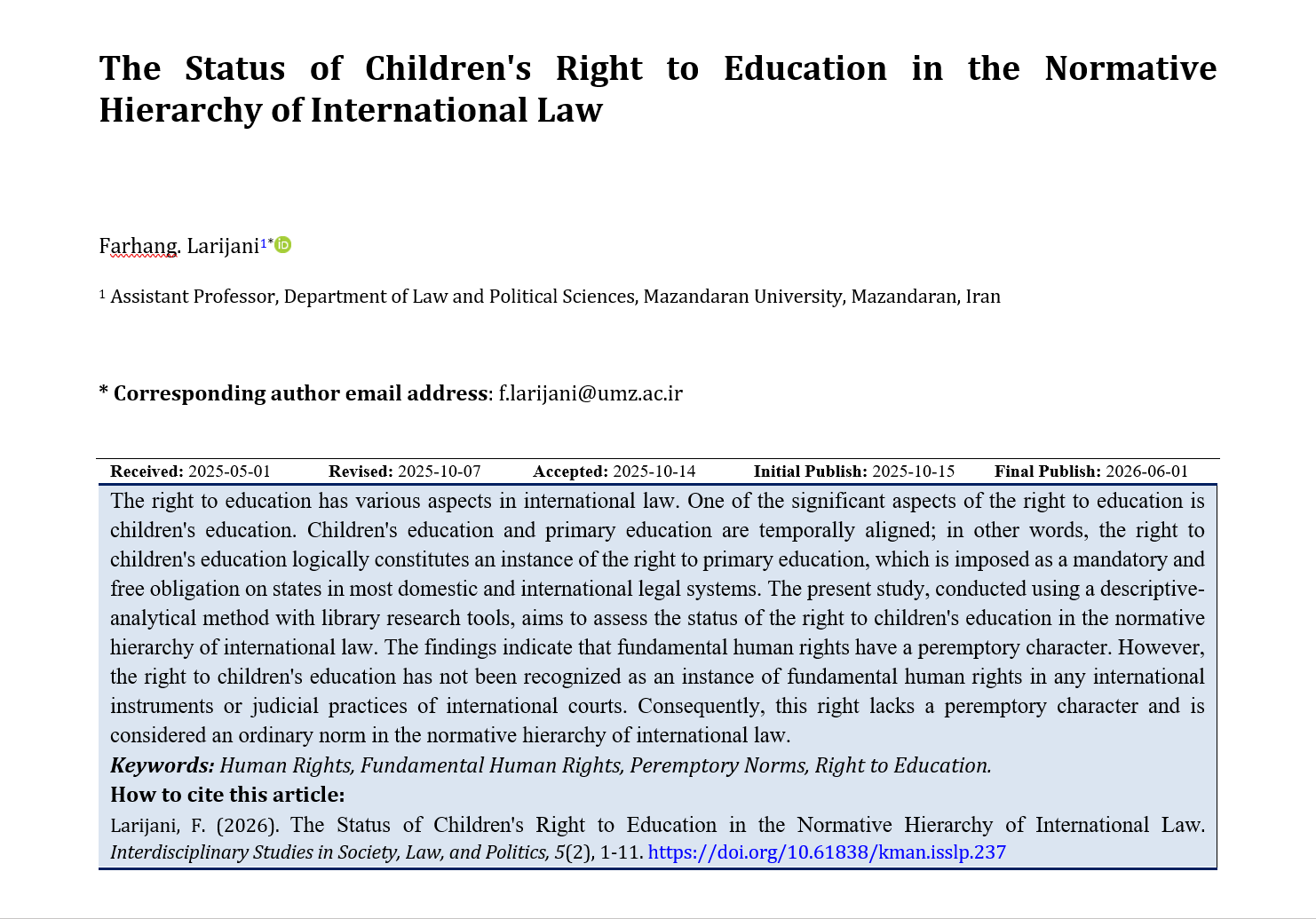The Status of Children's Right to Education in the Normative Hierarchy of International Law
Keywords:
Human Rights, Fundamental Human Rights, Peremptory Norms, Right to EducationAbstract
The right to education has various aspects in international law. One of the significant aspects of the right to education is children's education. Children's education and primary education are temporally aligned; in other words, the right to children's education logically constitutes an instance of the right to primary education, which is imposed as a mandatory and free obligation on states in most domestic and international legal systems. The present study, conducted using a descriptive-analytical method with library research tools, aims to assess the status of the right to children's education in the normative hierarchy of international law. The findings indicate that fundamental human rights have a peremptory character. However, the right to children's education has not been recognized as an instance of fundamental human rights in any international instruments or judicial practices of international courts. Consequently, this right lacks a peremptory character and is considered an ordinary norm in the normative hierarchy of international law.
Downloads
References
Aghaei, B. (2004). Human Rights Culture. Tehran: Ganj Danesh Library.
Albi, A. (2019). National Constitutions in European and Global Governance: Democracy, Rights, the Rule of Law. Hague: Springer. https://doi.org/10.1007/978-94-6265-273-6
Arechaga, E. J. (1978). International law in the past third of a century. Hague: Sijthoff.
Criddle, E. (2016). Fiduciaries of Humanity: How International Law Constitutes Authority. Oxford: Oxford University Press. https://doi.org/10.1093/acprof:oso/9780199397921.001.0001
EbrahimGol, A. (2023). International Responsibility of the State. Tehran: Shahrdanesh Institute of Legal Studies and Research.
Green, J. A. (2015). Adjudicating International Human Rights: Essays in Honour of Sandy Ghandhi. London: Brill Nijhoff. https://doi.org/10.1163/9789004261181
Hatami, M., & Zahedi, M. (2013). The Right to Education and the Number of States. Tehran: Khorsandi Publications.
ICJ. (2007). Reports Case Concerning Application of the Convention on the Prevention and Punishment of the Crime of Genocide. Hague: ICJ Press.
ILC. (1976). Reports Year Book of the International Law Commission, Volume 2. Hague: ICJ Press.
ILC. (2001). Reports Commentary of the commission on draft articles on responsibility of states for internationally wrongful acts. New York: UN Press.
Kapros, E., & Koutsombogera, M. (2018). Designing for the User Experience in Learning Systems. London: Springer. https://doi.org/10.1007/978-3-319-94794-5
Khani Valizadeh, S., & Lotfi, A. (2017). Study of the Right to Education in the Constitutional Law of the Islamic Republic of Iran. Bi-Quarterly Journal of Constitutional Law, 14(2).
Khazaei, A. R., Yaqouti, E., & Beiranvand, F. (2019). Essays on Mandatory Rules and Universal Obligations. Tehran: Islamic Azad University, Central Tehran Branch Publications.
Meron, T. (1986). On a Hierarchy of International Human Rights. The American Journal of International Law, 80, 9.
Mohammadi-Gorgani, M. (2014). An Essay on the Constitution of the Islamic Republic of Iran. Tehran: Shahr Danesh Institute for Legal Studies and Research.
Niavarani, S. (2010). The Status of the Right to Education in the International Human Rights System. Journal of Legal Research, 52(1).
Pendergast, D., & Main, K. (2019). Teaching Primary Years: Rethinking curriculum, pedagogy and assessment. London: Crow's Nest. https://doi.org/10.4324/9781003117797
Qari Seyyed Fatemi, S. M. (2009). Human Rights in the Contemporary World. Tehran: Shahr Danesh Publications.
Rostami, S., & Soleimanzadeh Afshar, S. (2020). Rethinking the concept of the right to education in the light of democratic citizenship. Journal of Bioethics-Scientific Research, 10(1).
Smith, R. (2012). Textbook on International Human Rights. Oxford: Oxford University Press. https://doi.org/10.1080/14754835.2012.648146
Thirlway, H. (2019). The Sources of International Law. Oxford: Oxford University Press. https://doi.org/10.1093/law/9780198841814.001.0001
Tomuschat, C. (2006). The Fundamental Rules of the International Legal Order. London: Martinus Nijhoff Publishers. https://doi.org/10.1163/ej.9789004149816.i-472
Villiger, M. E. (2009). Commentary on the 1969 Vienna convention on the law of treaties. Hague: Martinus Nijhoff Publisher. https://doi.org/10.1163/ej.9789004168046.i-1058
Weatherall, T. (2015). Jus Cogens: International Law and Social Contract. Cambridge: Cambridge University Press. https://doi.org/10.1017/CBO9781139976664
Zamani, S. G. (2009). Law of International Organizations. Tehran: Shahr Danesh Legal Studies and Research Institute.

Downloads
Additional Files
Published
Submitted
Revised
Accepted
Issue
Section
License
Copyright (c) 2025 farhang Larijani (Author)

This work is licensed under a Creative Commons Attribution-NonCommercial 4.0 International License.





